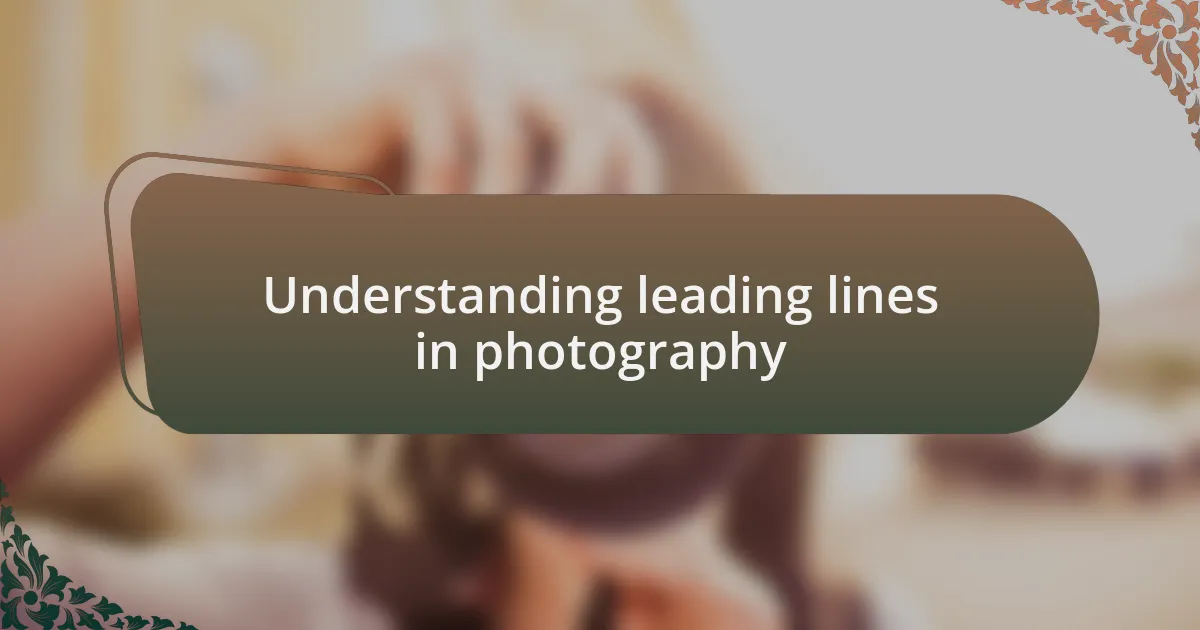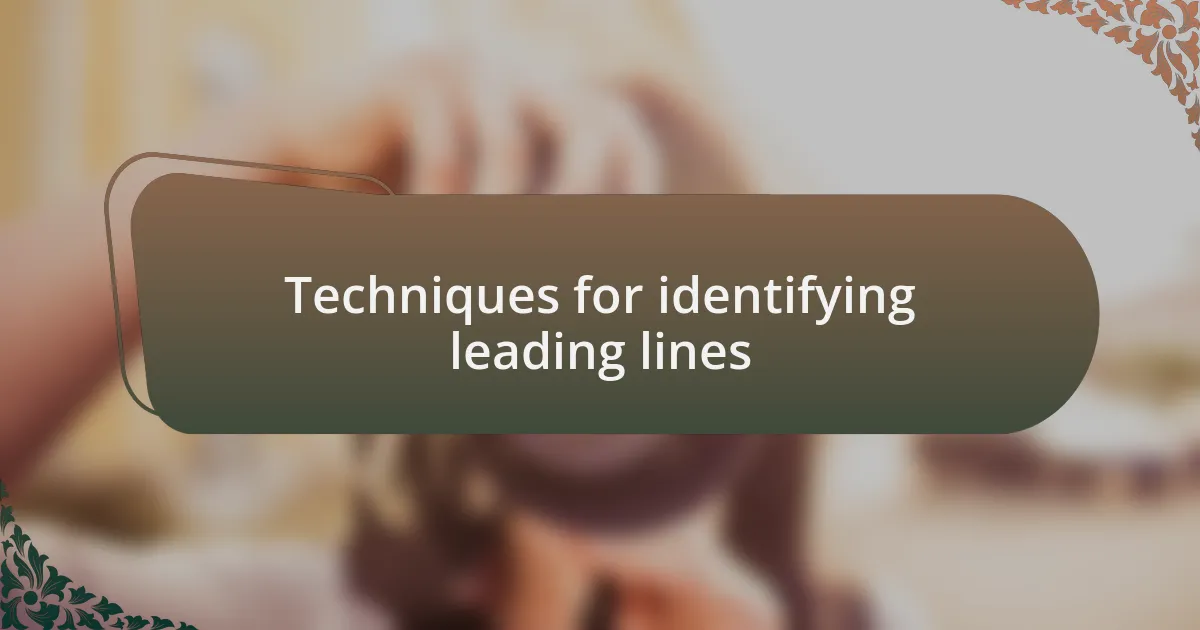Key takeaways:
- Leading lines effectively guide the viewer’s eye and evoke emotion in photography, transforming ordinary scenes into engaging narratives.
- Composition is crucial in photography, shaping the viewer’s emotional connection and enhancing storytelling through elements like balance and arrangement.
- Identifying leading lines can occur in both natural and urban environments, emphasizing the importance of being open-minded and observant while capturing images.
- Personal experiences with leading lines highlight their ability to evoke nostalgia and harmony, showcasing the beauty in unexpected moments and settings.

Understanding leading lines in photography
Leading lines are powerful compositional tools that guide the viewer’s eye through a photograph. When I first experimented with leading lines, I realized how effectively they could create depth and a sense of direction in an image. It’s fascinating to think about how something as simple as a road or a fence can lead you into the heart of a photograph, right?
When I was wandering through a dense forest, I stumbled upon a narrow path flanked by towering trees. I quickly raised my camera, and the lines formed by the path created a natural guide leading the viewer toward the distant light peeking through the branches. It struck me then how leading lines aren’t just structural; they evoke emotion and narrative, pulling the viewer into the story behind the image.
An important aspect to remember is that leading lines aren’t limited to obvious pathways. Sometimes, I’ve found that shadows, reflections, or even the arrangement of objects can create these lines. Have you ever looked at a scene and thought, “How can I use that to draw someone’s attention?” Experimenting with different perspectives allows you to discover unique lines that can transform an ordinary photograph into something extraordinary.

Importance of composition in photography
Composition is the backbone of photography, shaping how we perceive and emotionally connect with an image. I remember attending a gallery opening once, where the curator emphasized that every photograph tells a story through its composition. It made me reflect on how elements like balance, symmetry, and the arrangement of subjects can transform a simple snapshot into a captivating narrative. Have you ever looked at a photo and felt an undeniable pull? That’s the power of effective composition at work.
When I first started photographing landscapes, I often overlooked how the arrangement of elements could lead to a stronger image. I vividly recall a moment by a serene lake at sunset. By positioning the horizon line just below center and allowing the reflections of trees to guide the eye across the frame, I created a sense of tranquility that resonated with viewers. It was evident to me that the way I composed that shot wasn’t just a technical decision; it was an emotional one that spoke to the viewer’s experience.
Moreover, good composition invites the viewer to engage with the image on a deeper level. I often ask myself, “What do I want the viewer to feel?” This question pushes me to consider every line, shape, and color in the frame. The balance and placement of these elements are vital in evoking feelings of harmony or tension, leaving a lasting impression. Understanding this aspect of composition has greatly enriched my photography journey, allowing me to create images that not only depict a scene but also convey a story and emotion.

Techniques for identifying leading lines
When I scan a scene, I often search for natural borders that can serve as leading lines—like a path or a row of trees. Once, during a hike, I stumbled upon a winding trail framed by lush foliage. As I framed my shot, I realized that the way the trail curved made the viewer’s eye travel deeper into the image, inviting them on a journey through the photograph.
Something I’ve learned over time is that leading lines can also be found in unexpected places. I remember photographing an urban landscape, where the sharp angles of skyscrapers created striking diagonal lines. By positioning myself at an angle, I emphasized these lines, drawing attention to the height and grandeur of the buildings. It made me think: how often do we overlook the beauty in our surroundings simply because we fail to look for these guiding elements?
A crucial technique is to keep an open mind and be conscious of the environment. One day, I was capturing the hustle of a city street when I noticed a bus stop sign and the lines created by the waiting pedestrians. I quickly adjusted my composition to incorporate those lines, which added a dynamic element to the image. It was a moment of realization that leading lines are everywhere; we just need to train our eyes to see them. Do you find yourself searching for these lines in your own photography? It’s a rewarding challenge that can truly elevate your work.

Personal experiences with leading lines
There was a time when I was exploring an abandoned railway station, and I couldn’t help but notice the long, rusted tracks leading away into the distance. As I composed the shot, I felt a surge of nostalgia; the tracks seemed to tell stories of journeys past. It struck me that leading lines not only guide the viewer’s eye but also evoke emotions and memories associated with the scene.
On another occasion, while photographing a local farmer’s market, I was drawn to the colorful rows of produce arranged on the stalls. The vibrant lines created by the neatly organized fruits and vegetables naturally led my gaze across the frame. I remember thinking how these lines created a sense of harmony, making the image lively and inviting. Have you ever realized how color and shape can work together to create compelling leading lines?
Often, I’ve found that the best leading lines come from moments when I least expect them. While walking along a beach at sunset, I noticed the way the receding tide left behind patterns in the sand that led toward the horizon. Capturing that moment felt like a gentle reminder that beauty can be found in the simplest of things, and I often wonder how many opportunities I might miss if I don’t remain open to the unexpected.